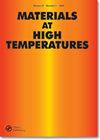Study on the composition, microstructure and properties of new W-Al alloyed ethylene cracking furnace tube under 1100 ℃ carburising test conditions
IF 0.9
4区 材料科学
Q4 MATERIALS SCIENCE, MULTIDISCIPLINARY
引用次数: 0
Abstract
ABSTRACT The carburising tests were carried out at 1100 ℃ for 50 h, 100 h, 150 h and 200 h for a new type of tungsten-aluminium alloyed ethylene cracking furnace tube. The composition, microstructure transformation and performance of furnace tubes were analysed. The results showed that the average carbon content within 1 mm of the inner wall increased with the prolongation of carburising time. The thickness of carburised layer increased from 0.3 mm to 1.5 mm. The carbides in as cast structure were mainly massive (Cr, Fe, W)23C6 on the outside and fishbone (Cr, Fe, W)7C3 on the inside. During carburising process, the external (Cr, Fe, W)23C6 carbides coarsened and transformed into (Cr, Fe)7C3, and then gradually transformed into (Cr, Fe, W)7C3. Carbide coarsening mainly occurred in internal (Cr, Fe, W)7C3 during carburising. The carbide precipitation and transformation also led to Vickers hardness value of furnace tube increased.1100℃渗碳试验条件下新型W-Al合金乙烯裂解炉管的组成、组织和性能研究
对一种新型钨铝合金乙烯裂解炉管进行了1100℃、50 h、100 h、150 h和200 h的渗碳试验。分析了炉管的成分、组织变化及性能。结果表明:随着渗碳时间的延长,合金内壁1mm内的平均含碳量增加;渗碳层厚度由0.3 mm增加到1.5 mm。铸态组织中碳化物主要为块状(Cr, Fe, W)23C6,内部为鱼骨状(Cr, Fe, W)7C3。渗碳过程中,外部的(Cr, Fe, W)23C6碳化物变粗,转变为(Cr, Fe)7C3,再逐渐转变为(Cr, Fe, W)7C3。渗碳过程中碳化物粗化主要发生在内部(Cr, Fe, W)7C3中。碳化物的析出和相变也导致炉管的维氏硬度值升高。
本文章由计算机程序翻译,如有差异,请以英文原文为准。
求助全文
约1分钟内获得全文
求助全文
来源期刊

Materials at High Temperatures
工程技术-材料科学:综合
CiteScore
1.90
自引率
15.40%
发文量
58
审稿时长
>12 weeks
期刊介绍:
Materials at High Temperatures welcomes contributions relating to high temperature applications in the energy generation, aerospace, chemical and process industries. The effects of high temperatures and extreme environments on the corrosion and oxidation, fatigue, creep, strength and wear of metallic alloys, ceramics, intermetallics, and refractory and composite materials relative to these industries are covered.
Papers on the modelling of behaviour and life prediction are also welcome, provided these are validated by experimental data and explicitly linked to actual or potential applications. Contributions addressing the needs of designers and engineers (e.g. standards and codes of practice) relative to the areas of interest of this journal also fall within the scope. The term ''high temperatures'' refers to the subsequent temperatures of application and not, for example, to those of processing itself.
Materials at High Temperatures publishes regular thematic issues on topics of current interest. Proposals for issues are welcomed; please contact one of the Editors with details.
 求助内容:
求助内容: 应助结果提醒方式:
应助结果提醒方式:


